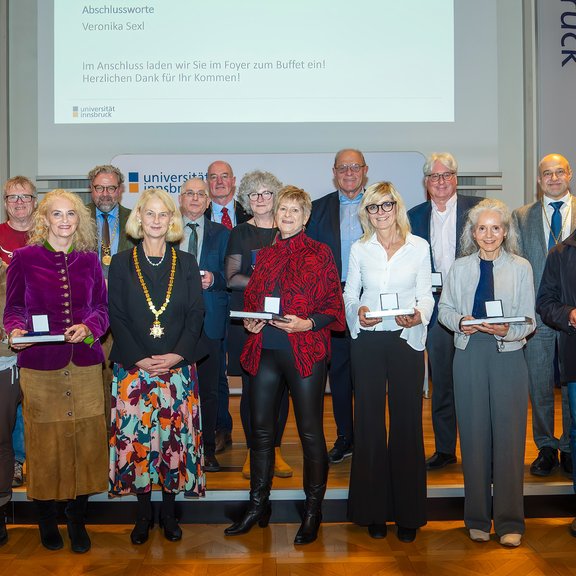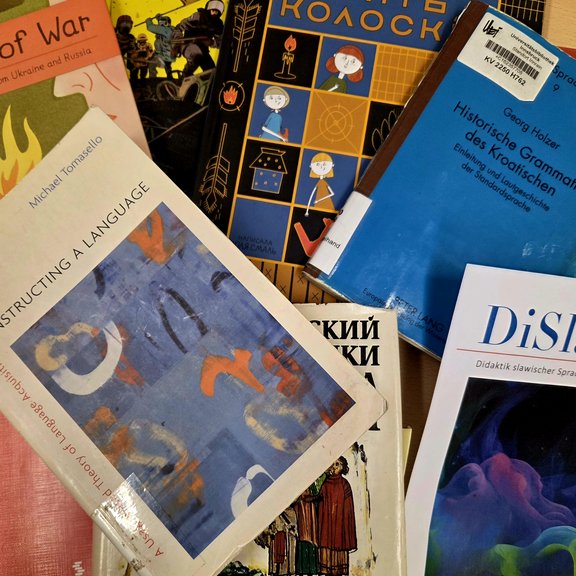Herzlich willkommen an der Philologisch-Kulturwissenschaftlichen Fakultät!
Die Fakultät umfasst ein breites Fächerspektrum von der Amerikanistik bis zur Translationswissenschaft. Sie gehört zu den größten Fakultäten der Leopold-Franzens-Universität Innsbruck.
Unsere Kernkompetenzen liegen in zwei eng miteinander verbundenen Feldern:
den einzelnen Sprachen, Literaturen, Medien undKulturen im Bereich von Anglistik/Amerikanistik, Germanistik, Latinistik/Gräzistik, Romanistik und Slawistik
deren Grundlagen, Kontakten und Wechselwirkungen: Sprachwissenschaft, Translationswissenschaft und Vergleichende Literaturwissenschaft.
Ein wesentlicher Bestandteil des Profils der Philologisch-Kulturwissenschaftlichen Fakultät ist der Auftrag zur Vermittlung:
zwischen Grundlagen- und angewandter Forschung (z.B. im Verhältnis von Fach- und Lehramtsstudiengängen)
zwischen Universität und Öffentlichkeit (z.B. in den Länderzentren oder im Forschungsinstitut Brenner-Archiv einschließlich des Literaturhauses am Inn)
zwischen regionaler Verankerung und der Einbindung in die internationale scientific community.
News von der Phil.-Kult.

16. ADI-Tagung in Innsbruck
Am 14. und 15. November 2025 fand die 16. Konferenz der ADI (Associazione Docenti d’Italiano nei paesi di lingua tedesca) unter dem Titel „L’insegnante d’italiano fra didattica tradizionale e nuove tecnologie“ in Innsbruck statt. Über 120 Lehrkräfte aus Deutschland, Österreich, der Schweiz sowie Italien nahmen daran teil.

Erfolgreiche FWF-Bewilligungsrunde
Bei der letzten FWF-Kuratoriumssitzung wurden sechs Einzelprojekte und ein ESPRIT-Projekt bewilligt. Außerdem koordinieren Wissenschaftler:innen der Universität Innsbruck je einen neuen Spezialforschungsbereich und eine Forschungsgruppe und sind an je einem weiteren Spezialforschungsbereich und einer Forschungsgruppe beteiligt.

Feierliche Verabschiedung in den Ruhestand
Mit einem feierlichen Festakt wurden am 10. Dezember langjährige Mitarbeiter:innen aus Wissenschaft und Verwaltung in den Ruhestand verabschiedet. Die Veranstaltung, die in der Aula der Universität stattfand, würdigte die Verdienste der Kolleg:innen.

Forschungstag des Instituts für Slawistik
Der Forschungstag des Instituts für Slawistik bot einen umfassenden Einblick in die laufenden und abgeschlossenen Projekte der Institutsmitglieder. Die Beiträge zeigten die thematische Vielfalt sowie methodische Bandbreite der slawistischen Forschung und förderten den interdisziplinären Austausch.
Gastvortrag von Anna-Marie Píplová zum Thema: Erudition and Credibility in Seventeenth-Century Bohemian Catholic Historiography
10.12.2025 | 09:15 Uhr | Seminarraum 7 des Ágnes-Heller-Haus (Details)
Montag |12:00 |31.03.2025 | Raum 40628
Kann Literatur handeln? Überlegungen am Beispiel der post-jugoslawischen Kriegsliteratur (Details)
Veranstaltungen

Career Days
Die Career Days an der Phil.-Kult. Fakultät sind eine Veranstaltungsreihe, die Studierenden der Geisteswissenschaften Möglichkeiten bietet, sich über Karrierewege und Branchen zu informieren und mit Fachleuten in Kontakt zu treten.

Writer in Residence 2025
Antje Rávik Strubel
Die Phil.-Kult. Fakultät geht mit der Einladung eines "Writer in Residence" einen neuen Weg, um Literatur anregend mit Forschung und Lehre zu verbinden.
Kontakt
Dekanat Philologisch-Kulturwissenschaftliche Fakultät
Bruno-Sander-Haus, 5. Stock
Innrain 52f
6020 Innsbruck
find us on Instagram: #philkultuibk
Karrieremöglichkeiten an der Fakultät
Bitte informieren Sie sich über Stellenangebote auf den jeweiligen Webseiten der Universität.




